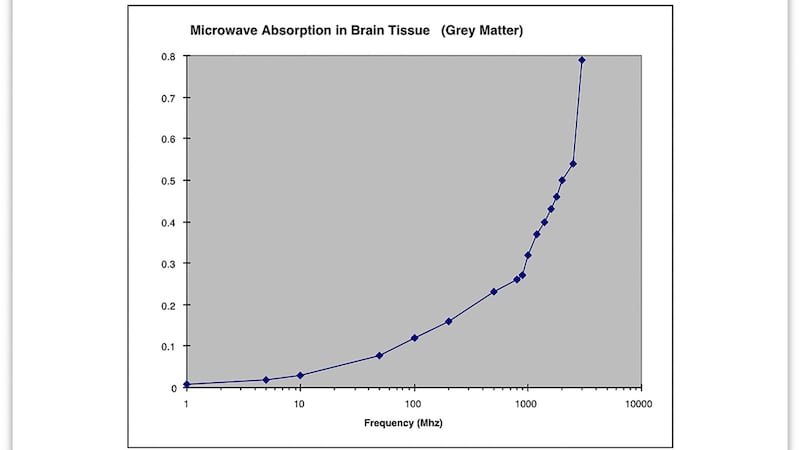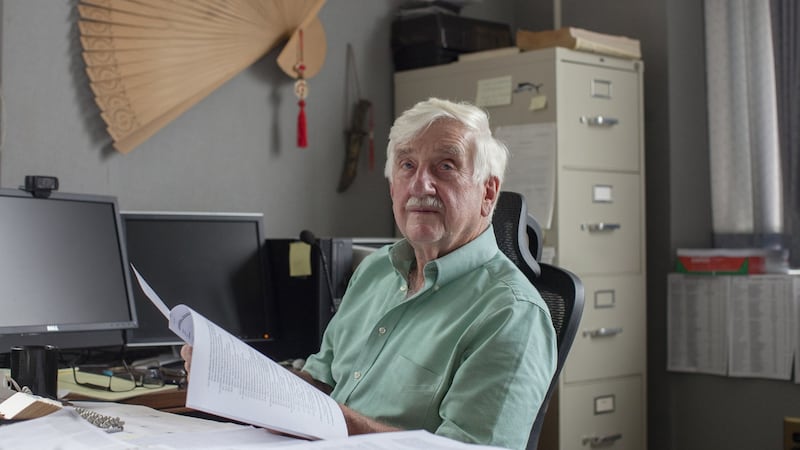In 2000, the Broward County Public Schools in Florida received an alarming report. Like many affluent school districts at the time, Broward was considering laptops and wireless networks for its classrooms and 250,000 students.
Were there any health risks to worry about?
The district asked Bill P Curry, a consultant and physicist, to study the matter. The technology, he reported back, was “likely to be a serious health hazard”. He summarised his most troubling evidence in a large graph labelled “Microwave Absorption in Brain Tissue (Grey Matter).”
The chart showed the dose of radiation received by the brain as rising from left to right, with the increasing frequency of the wireless signal. The slope was gentle at first, but when the line reached the wireless frequencies associated with computer networking, it shot straight up, indicating a dangerous level of exposure. “This graph shows why I am concerned,” Curry wrote.
The body of his report detailed how the radio waves could sow brain cancer, a terrifying disease that kills most of its victims.
Over the years, Curry’s warning spread far, resonating with educators, consumers and entire cities as the frequencies of cellphones, cell towers and wireless local networks rose. To no small degree, the blossoming anxiety over the professed health risks of 5G technology can be traced to a single scientist and a single chart.
Except that Curry and his graph got it wrong.

According to experts on the biological effects of electromagnetic radiation, radio waves become safer at higher frequencies, not more dangerous. (Extremely high-frequency energies, such as X-rays, behave differently and do pose a health risk.)
In his research, Curry looked at studies on how radio waves affect tissues isolated in the lab and misinterpreted the results as applying to cells deep inside the human body. His analysis failed to recognise the protective effect of human skin. At higher radio frequencies, the skin acts as a barrier, shielding the internal organs, including the brain, from exposure. Human skin blocks the even higher frequencies of sunlight. "It doesn't penetrate," said Christopher M Collins, a professor of radiology at New York University who studies the effect of high-frequency electromagnetic waves on humans. Curry's graph, he added, failed to take into account "the shielding effect".
Dr Marvin C Ziskin, an emeritus professor of medical physics at Temple University School of Medicine in Philadelphia, agreed. For decades, Ziskin explored whether such high frequencies could sow illness. Many experiments, he said, support the safety of high-frequency waves.
Alarmist websites
Despite the benign assessment of the medical establishment, Curry’s flawed reports were amplified by alarmist websites, prompted articles linking mobile phones to brain cancer and served as evidence in lawsuits urging the removal of wireless classroom technology. In time, echoes of his reports fed Russian news sites noted for stoking misinformation about 5G technology. What began as a simple graph became a case study in how bad science can take root and flourish. “I still think there are health effects,” Curry said in an interview. “The federal government needs to look at it more closely.”
Curry was not the first to endorse the idea that advances in wireless technology could harbour unforeseen risks. In 1978, Paul Brodeur, an investigative journalist, published The Zapping of America, which drew on suggestive but often ambiguous evidence to argue that the growing use of high frequencies could endanger human health.
In 2000, Curry, writing on letterhead from his home office in the Chicago suburbs, sent the Broward district two reports, the first in February 2000 and the second in September of that year. The latter study went to the superintendent, the school board and the district's head of safety and risk management.
The frequency graph in the second report was far more detailed. Its rising line bore annotations noting the precise locations for the wireless-network dose and, far lower down, for radio, television and mobile phone signals. Overall, Curry’s reports cast the emerging topic as crucial for public health. He warned that children were especially vulnerable to the cancer risk of wireless technology. “Their brains are developing,” he noted in his first report.
Curry belonged to a national group of wireless critics, and his two reports for the Broward district soon began to circulate widely among industry foes. One reached Dr David O Carpenter, who for decades had clashed with the science establishment on the health risks of radio waves.
Carpenter’s credentials were impressive. From 1985 to 1997, he served as dean of the School of Public Health at the State University of New York in Albany and in 2001 became director of its Institute for Health and the Environment, where he still works. His resume lists hundreds of journal reports, jobs, grants, awards, advisory boards, books and legal declarations.
Carpenter stirred global controversy in the 1980s by asserting that high-voltage power lines could cause leukemia in nearby children. He appeared as an authority in Brodeur’s 1989 book, Currents of Death. But federal researchers failed to find solid evidence to support the warnings.
In late 2011, Carpenter introduced Curry’s graph in a lawsuit that sought to force the Portland, Oregon, public schools to abandon their wireless computer networks. The suit had been filed by a worried parent.
As an expert witness, Carpenter said in a legal declaration on December 20th, 2011, that the graph showed how the brain’s absorption of radio-wave energy “increases exponentially” as wireless frequencies rise, calling it evidence of grave student danger. The graph “illustrates the problem with the drive of the wireless industry toward ever higher frequencies,” he said.
In response to such arguments, the industry noted it obeys government safety rules. The judge in the Portland case said the court had no jurisdiction over federal regulatory matters and dismissed the lawsuit.
Unbowed, Carpenter worked hard to revise established science. In 2012, he became editor-in-chief of Reviews on Environmental Health, a quarterly journal. He published several authors who filed alarmist reports, as well as his own. “The rapid increase in the use of cellphones increases risk of cancer, male infertility, and neurobehavioural abnormalities,” Carpenter wrote in 2013.

5G
In subsequent years, as the frequencies of wireless devices continued to rise, an associated risk of brain cancer was repeated uncritically, often without attribution to Curry or Carpenter. Instead, it came to be regarded by activists as an established fact of modern science.
“The higher the frequency, the more dangerous,” according to Radiation Health Risks, a website, in reference to signals from 5G towers. The idea was echoed by a similar website, 5G Exposed – Higher frequencies are more dangerous to health – on a page entitled, Scientific Discussion. Overall, the site bristled with brain-cancer warnings.
5G is the next generation of mobile connectivity which succeeds the current 4G and older 3G systems. It stands for fifth generation and should deliver faster speeds, more reliable connections and more consistent ones too. 5G networks are expected to begin arriving in Ireland as a commercial concern very soon, with Vodafone already testing its network in a limited capacity.
Recently, Carpenter told RT America, a Russian television network, that the newest mobile phones represented a dire health threat. “The rollout of 5G is very frightening,” he said. “Nobody is going to be able to escape the radiation.”
In recent months, the network has run a series of segments critical of 5G technology. “The higher the frequency, the more dangerous it is to living organisms,” a RT reporter told viewers this year. The show described children as particularly vulnerable.
The new mobile phones are to employ a range of radio frequencies up to dozens of times higher than those Curry identified two decades ago as endangering student health. But mainstream scientists continue to see no evidence of harm from cellphone radio waves.
"If phones are linked to cancer, we'd expect to see a marked uptick," David Robert Grimes, a cancer researcher at the University of Oxford, wrote recently. "Yet we do not."
In a recent interview, Carpenter defended his high-frequency view. “You have all this evidence that cellphone radiation penetrates the brain,” he said. But he conceded after some discussion that the increasingly high frequencies could in fact have a difficult time entering the human body: “There’s some legitimacy to that point of view.”
He noted that, in cities, 5G service requires the placement of many antenna towers because walls, buildings, rain, leaves and other objects can block the high-frequency signals. “That’s why they put the towers so close together,” he said. “The waves don’t penetrate.” If human skin also blocks 5G signals, Carpenter acknowledged, “maybe it’s not that big a deal”.
Curry, now 82, was less forthcoming. In an interview, he said he no longer follows the wireless industry and disavowed any knowledge of having made a scientific error. “They can say whatever they want,” Curry said of his detractors. “I’ll leave it to the young in the business and let them figure it out.” – New York Times
[ Press Ombudsman decision on Prof Tom Butler and The Irish TimesOpens in new window ]
Phones Special
- Can mobile phone use cause cancer?
- Medical devices & apps on phones
- Professed health risks of 5G
- Could you be 'allergic' to your phone?
- Smartphone addiction
- 'An extension of my arm'
- Limiting your child's screentime
- Monitoring my daughter's phone
- Parents need to lead by example
- Teenagers on the phones in their hands
- Parents still need to snoop and ration
- How 'technoference' impacts parenting
- The schools banning mobile phones
- Spending months playing video games
- Using your phone in the supermarket
- Do you run with your phone?














